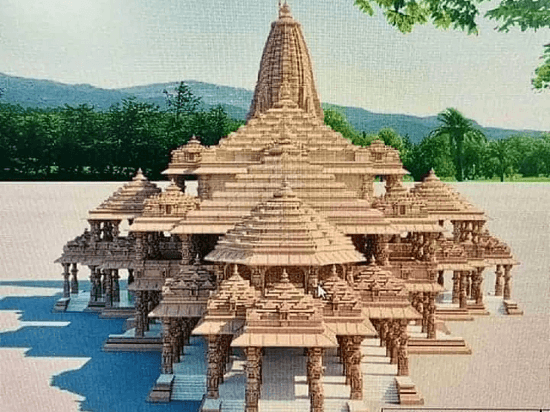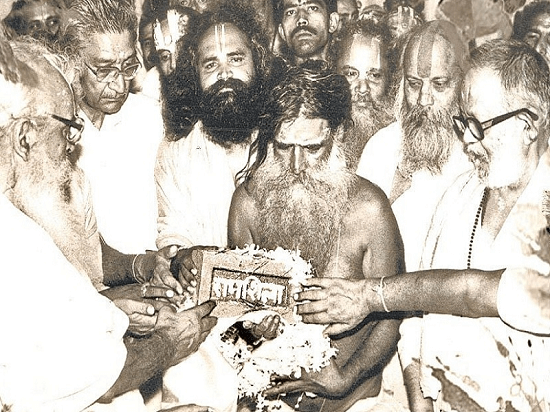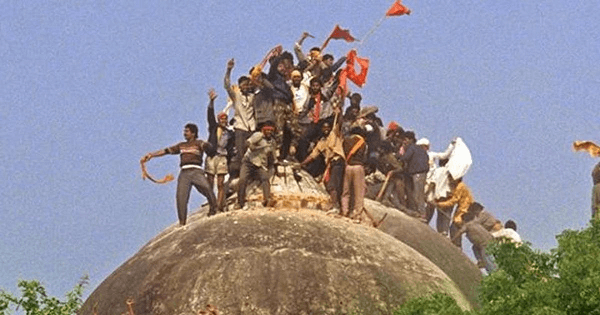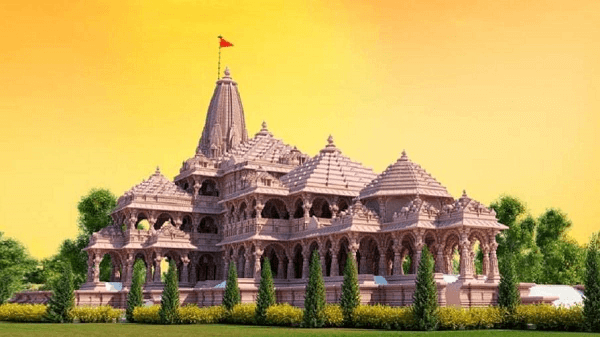Ayodhya TempleAt the location of Ram Janmabhoomi, the birthplace of Rama, one of the supreme gods of Hinduism, according to the Ramayana, a Hindu temple named Ram Mandir is now being constructed in Ayodhya, Uttar Pradesh, India. The Shri Ram Janmabhoomi Teerth Kshetra is in charge of supervising the construction of the temple. Prime Minister of India Narendra Modi laid the foundation stone on August 5, 2020. 
HistoryRama, a manifestation of the almighty Vishnu, is a popular Hindu deity. Rama was born at Ayodhya, according to the ancient Indian epic, the Ramayana. The Babri Masjid, a mosque built by the Mughals in the sixteenth century, is thought to be located near the Ram Janmabhoomi, the reputed birthplace of Rama. In the 1850s, a fierce disagreement developed. The Vishwa Hindu Parishad (VHP), a member of the Sangh Parivar family of Hindu nationalists, started a fresh push to reclaim the location for Hindus and to build a temple honouring the young Rama (Ram Lalla) there in the 1980s. On a plot of property next to the contentious mosque, the VHP began construction on a temple in November 1989. 150,000 karsevaks, or volunteers, participated in a rally organised by the VHP on December 6, 1992, at the location. The crowd overpowered the security personnel during the violent march and tore the mosque down. At least 2,000 people were killed during months of inter-communal violence among Hindu and Muslim populations in India due to the demolition, which also spread unrest across the entire Indian subcontinent. The New York Times reported that more than 30 Hindu temples in Pakistan had been attacked, with some being set on fire and one being destroyed, on December 7, 1992, a day after the mosque had been destroyed. On a day of protest, the Pakistani government shut down all businesses and schools. Attacks were also made against Hindu temples in Bangladesh. Since the Babri Masjid's reaction, most of these Hindu temples that have been heavily damaged have stayed that way. Five terrorists assaulted the temporary Ram temple in Ayodhya, India, on July 5, 2005, where the Babri Mosque had been razed. One civilian perished in the grenade attack that the assailants used to break the cordoned-off wall, and all five were shot dead in the ensuing battle with the Central Reserve Police Force (CRPF). Three people were lost to the CRPF, two of whom had numerous bullet wounds and were critically injured. The Archaeological Survey of India (ASI) carried out archaeological studies between 1978 and2003, during which the ruins of a Hindu temple were revealed. Several historians, according to archaeologist KK Muhammad, have questioned the results. Numerous title and legal conflicts also occurred throughout time, leading to the 1993 adoption of the Acquisition of Certain Areas at Ayodhya Ordinance. It wasn't until the 2019 Supreme Court ruling on the Ayodhya issue that it was decided the disputed land should be transferred to an Indian government trust established to construct a Ram temple. Shri Ram Janmabhoomi Teerth Kshetra was the final name given to the trust. The mosque was given five acres of land in the village of Dhannipur, 22 kilometres from the city. The Narendra Modi administration stated in the Parliament on February 5, 2020, that it had approved a plan to build the temple. Ram Janmabhoomi (Rama's Birthplace)One of the most popular Hindu deities, Rama is regarded as the seventh manifestation of the god Vishnu. The Ramayana claims that Rama was a prince born in Ayodhya to parents Kaushalya and Dasharatha during the Treta Yuga, thousands of years before the Kali Yuga, which Hindu history claims to have started in 3102 BCE. Many more locations in Ayodhya and the entire fortified town, known as Ramadurga ("Rama's fort"), were added as pilgrimage sites in a later recension. DeityThe temple's principal deity is Ram Lalla Virajman, an avatar of Vishnu who represents Rama as an infant. Bhagwat Prasad and Shankar Lal, a 4th generation weaver of Rama's idol, sew the garment for Ram Lalla. Ram Lalla was a party to the legal issue involving the disputed site since 1989 and was therefore regarded by the law as a "juristic person." Triloki Nath Pandey, a prominent VHP figure regarded as Ram Lalla's next "human" friend, stood in for him. According to the temple trust, the final layout calls for building Surya, Ganesha, Shiva, Durga, Vishnu, and Brahma temples on the temple grounds. Beginnings of Dispute
In Ayodhya, the earliest instances of religious violence were first noted in 1855. Certain "The mosque that once stood atop it, according to Sunnis, was destroyed by the Bairagis of Hanumangarhi. The Muslims attacked Hanumangarhi, but they were repulsed and defeated. They sheltered within Babur's mosque, which was located less than a kilometre away from Hanumangarhi." Hindus attacked the Babri mosque as a result. Since then, local Hindu organisations have made sporadic requests for the site's possession and permission to erect a temple there, all of which have been rejected by the colonial authorities. A campaign for the site's ownership was launched in 1946 by the Akhil Bharatiya Ramayana Mahasabha (ABRM), a branch of the Hindu Mahasabha. Sant Digvijay Nath, a Gorakhnath Math member who joined the ABRM in 1949, organised a nine-day Ramcharit Manas recital during which Hindus broke into the mosque and installed Rama and Sita idols. The idols were said to have miraculously materialised within the mosque; the populace claimed it. The incident happened on December 22, 1949. Jawaharlal Nehru pushed for the removal of the idols, but, K. K. Nair, a local official with connections to the Hindu nationalist movement, refused to comply with the directives, arguing that doing so would spark communal unrest. The gates were closed by the police so that neither Muslims nor Hindus could enter. Priests were permitted access, but the idols remained and were still worshipped daily. Thus, the mosque had been effectively transformed into a temple. The Uttar Pradesh Sunni Central Waqf Board and the ABRM asserted their rights to the location by filing civil lawsuits in a local court. The gates remained sealed while the land was determined to be in dispute. The Gorakhnath branch of Hinduism, which has maintained its existence independently from the mainline Hindu nationalism of the Sangh Parivar, has been referred to as "the other saffron" by Christophe Jaffrelot. The two strands of "saffron politics" came together after the Vishva Hindu Parishad was established in 1964 and started campaigning for the Babri Masjid site. Despite being eventually fired for defying orders, district magistrate Nair rose to fame in his community and later joined the Bharatiya Janata Sangh as a politician. Demolition of Babri Mosque
In the 1980s, a fresh push to "reclaim" the location for Hindus and build a temple honouring the young Rama (Ramlala) there was started by the Vishwa Hindu Parishad (VHP), a member of the mainstream Hindu organisation Sangh Parivar. A district judge's decision to reopen the gates and allow Hindus to worship inside in 1986 significantly boosted the cause. To gain support for the initiative, BJP leader L. K. Advani started a "rath yatra" (pilgrimage procession) to Ayodhya in September 1990. Later, Advani asked in his autobiography, "If Muslims are allowed to an Islamic environment in Mecca, and if Catholics are permitted to a Christian culture in the Vatican, then why is it wrong for Hindus to seek a Hindu atmosphere in Ayodhya." Communal violence broke out in many cities after the yatra, which prompted the Bihar government to detain Advani. Despite this, a sizable group of Sangh Parivar activists, or "karsevaks," arrived in Ayodhya and attempted to attack the mosque. They were stopped by the paramilitary and police forces of Uttar Pradesh, which led to a fierce fight that resulted in the deaths of several karsevaks. The BJP withdrew its support, accusing the V.P. Singh-led central government of being weak, which called for new elections. The BJP boosted its share of seats in the Lok Sabha after winning a majority in the Uttar Pradesh legislative assembly in these elections. At the mosque's location, 150,000 VHP and KarSevaks participated in a rally organised by the VHP and its allies, including the BJP, on December 6, 1992. Speakers from the BJP, including Advani, Murli Manohar Joshi, and Uma Bharti, gave addresses during the ceremonies. During the talks, the crowd became agitated and stormed the mosque shortly after noon. There was a police cordon set up to guard the mosque, but it was vastly outnumbered. The mosque was attacked over a short period using various homemade weapons. The state government had promised the Indian Supreme Court that the mosque wouldn't be destroyed, but this nevertheless happened. In the rioting that followed the demolition, around 2000 people died. Numerous significant Indian cities saw rioting, including Mumbai, Bhopal, Delhi, and Hyderabad. The Liberhan Commission was established by the Indian government on December 16, 1992, to look into the events that led to the Babri Mosque's destruction. The commission had been in operation the longest in Indian history because of many extensions given by different administrations. The investigation implicated several individuals in the demolition, including VHP leaders Giriraj Kishore and Ashok Singhal, Atal Bihari Vajpayee, Lal Krishna Advani, Murli Manohar Joshi, and Kalyan Singh, who was the chief minister of Uttar Pradesh at the time. The commission also charged K. N. Govindacharya, a former leader of the RSS, and late Shiv Sena chief Bal Thackeray. The report claimed that many of these officials had delivered aggressive comments during the demonstration that sparked the demolition, relying on the accounts of multiple eyewitnesses. Additionally, it mentioned that they could have prevented the demolition if they had wanted to. Numerous Muslim organisations have persisted in expressing their outrage over the collapse of the contentious building. M. N. Gopal Das, the then-director of the Ram temple, got death threats over the phone in 2007. Many terrorist assaults by outlawed jihadi groups like the Indian Mujahideen used the destruction of the Babri Mosque as justification Previous Construction EffortsThe VHP gathered money and bricks with the phrase "Jai Shree Ram" engraved on them in the 1980s. At first, the Shilanyas were to be held somewhere other than the disputed site, as agreed upon by the central and state administrations. Later, the Rajiv Gandhi administration granted the VHP permission for Shilanyas (the foundation-laying ceremony), with the authorization being publicly communicated to the VHP leader Ashok Singhal by the then-Home Minister, Buta Singh. However, on November 9, 1989, a group of VHP officials and Sadhus erected the building by excavating a trench that was 7 cubic feet in size near the contested territory. The sanctum's main entrance, or Singhdwar, was built here. ArchitectureThe Sompura family of Ahmedabad created the initial design for the Ram temple in 1988. Chandrakant Sompura is the temple's principal architect. He received assistance from his two architect sons, Nikhil and Ashish Sompura. Over 100 temples worldwide, including the Somnath temple, have included the Sompuras in their design for at least 15 generations. In 2020, the Sompuras prepared a new design that differed slightly from the original in line with Vastu and the Shilpa shastras. The temple will be 360 feet long, 235 feet wide, and 161 feet tall. The temple complex will be the world's third largest Hindu shrine when finished. It is built in the Northern Indian religious architectural style known as Gujara-Chaulukya. The three-story main structure of the temple will be erected on an elevated platform. In the centre, between the garbhagriha (sanctum sanctorum) and the entrance, there will be three mandapas for Kudu, Nritya, and Rang.On the other side, there will be two mandapas for the Kirtan and Prarthana. Shikhara should be used to decorate the mandapas in the traditional Nagara style. The tallest Shikhara will be located above the Garbhagriha. The structure will have a total of 366 columns. The sanctum sanctorum will be octagonal, as specified by writings devoted to Vishnu temple architecture. The columns will each include 16 idols,nincluding the 12 manifestations of the goddess Saraswati, the 64 Chausath Yoginis, the 10 Dashavataras, and the avatars of Shiva. The stairway will be 16 feet wide. A complex comprising a prayer hall, a lecture hall, an educational institution, and additional amenities like a museum and a restaurant will be built on 57 acres of land in addition to the 10 acres on which the temple will be constructed. Construction
The Ram Temple's first construction phase was started by the Shri Ram Janmabhoomi Teerth Kshetra trust in March 2020. However, the 2020 China-India hostilities and the COVID-19 pandemic lockdown in India led to a brief halt in the building. A Shivaling, pillars, and broken idols were discovered while the building site was levelled and excavated. Ram's idol was temporarily relocated on March 25, 2020, in the presence of Chief Minister Yogi Adityanath. The Vijay Mahamantra Jaap Anushthan, organized by the Vishwa Hindu Parishad in advance of its construction, would see people congregate in various locations to recite the Vijay Mahamantra, Shri Ram, Jai Ram, Jai Jai Ram on April 6, 2020. This was intended to ensure "winning over obstacles" as the temple was built. Larsen & Toubro, the project's contractor, freely offered to oversee the temple's planning and construction. Tata Consulting Engineers has been identified as a project management consultant. The Central Building Research Institute, National Geophysical Research Institute, and Indian Institutes of Technology (such as those in Bombay, Guwahati, and Madras) assist in soil testing, concrete, and design. Rumours claim that the Indian Space Research Organization (ISRO) has discovered a Sarayu stream that flows beneath the temple. Sandstone Bansi mountain stones from Rajasthan, totalling 600 000 cubic feet, will be used for the construction project. More than two hundred thousand bricks bearing the name "Sri Rama" in various languages had come from different regions of the nation thirty years prior; these will be used in the foundation. The shrine will be built using traditional methods, but it will also be reinforced to withstand earthquakes and other natural disasters. Iron won't be used in the construction of the temple. Ten thousand copper plates will be needed for the stone blocks to be fused. Bhoomi PujanOn August 5, 2020, a Bhoomi Pujan ritual began, and the temple construction resumed. Three days of Vedic ceremonies were held before the groundbreaking ceremony, including installing a 40 kg silver block as the foundation stone by India's Prime Minister Narendra Modi. The Ramarchan Puja on August 4 was dedicated to all major gods. In preparation for the Bhoomi Pooja, holy water and soil were gathered from several religious sites throughout India, including the Kamakhya Temple in Assam and the Triveni Sangam of the rivers Ganga, Yamuna, Saraswati, and Kaveri at Talakaveri. The forthcoming temple was also blessed with soil from other Hindu temples, Gurudwaras, and Jain Temples across the country. Sharada Peeth, which is in Pakistan, was one of the many. Additionally, soil from Char Dham's four pilgrimage sites was given. At Times Square, Rama's image was displayed. Additionally, the 7,000 temples within a 7 km radius of Hanumangarhi were asked to participate in the festivities by illuminating diyas. To obtain Hanuman's blessing for the day's activities, Prime Minister Modi first performed prayers at Hanumangarhi on August 5. Afterwards, the Ram Mandir's foundation stone laying and ground-breaking ceremonies were held. Jai Siya Ram was the opening phrase of Modi's address, and he encouraged the audience to shout the same phrase. "The call of Jai Siya Ram is echoing not only in the city of Lord Ram but around the world today," he said, adding that "Ram Mandir will become the modern icon of our traditions." Narendra Modi also expressed his gratitude to everyone who had sacrificed for the Ram temple. Mohan Bhagwat also acknowledged L. K. Advani for his support of the effort to have the temple built. Narendra Modi made a dandvat pranam (also known as a sashtang pranam) in front of the god by prostrating entirely to the ground and praying with his palms outstretched. There were only 175 people inside the temple because of the COVID-19 pandemic. Reactions to the Ground-Breaking CeremonySome priests and religious leaders expressed their anger over what they perceived to be a violation of normal ritual etiquette during the ceremony, citing, among other things, the fact that the event was not held on the traditionally auspicious date of August 5 and the lack of a Havan. In this regard, author Arundhati Roy, a well-known adversary of Modi, pointed out that the ceremony was planned for August 5, which she claimed was a bad day with no significance in the Hindu calendar, and claimed that it is symbolising the end of a period "in which India under Modi has openly announced itself a Hindu Country, the dawning of a new era." Pakistan issued a formal statement regarding the temple to the international community through its Pakistan Foreign Office. The Times of India further noted that Pakistani Hindus now fear violence, similar to what occurred in 1992 due to the Ram Mandir's ground-breaking. Several political figures in India praised the ground-breaking ceremony. While some openly rejoiced, others used careful wording in their remarks. Many voiced the expectation that adhering to Ram's beliefs would accelerate the nation's development. Residents of Ayodhya expressed optimism about the increase in job prospects and the growth of the city through tourism brought on by the temple soon after the ground-breaking ceremony. 2021-PresentAn observation area was established in August 2021 so that the public may observe the progress. Up to 40 feet of debris were eliminated, and the remaining earth was flattened after the official groundbreaking ceremony. By September 2021, 47-48 layers, each one foot high, had been finished. Sandstone cutting was slowed considerably at Mirzapur due to problems with the energy supply. The temple trust published a film at the start of 2022 that included information about the temple's construction plans and showed it being built in 3D. Supreme Court VerdictThe case's final hearing was heard by the Supreme Court (SC) from August 6, 2019, until October 16, 2019. The bench set aside the final ruling while giving contesting parties three days to submit written observations on "moulding of relief," or limiting the topics the court must decide. On November 9, 2019, the Supreme Court ruled in its entirety. The Supreme Court mandated that the land be given to a trust so that the Hindu temple may be built there. Additionally, it mandated that the Uttar Pradesh Sunni Central Waqf Board receive an alternative 5 acres of property from the government to construct a mosque. According to the court's ruling, the Nirmohi Akhara is not a she-bait or a follower of the deity Ram Lalla, and the Akhara's lawsuit was time-barred. On December 12, 2019, the Supreme Court dismissed all 18 petitions requesting a reconsideration of the judgement. Crowd-Funding, Outreach, and AllegationsTo reach 55-60 crore people, the temple trust decided to start a national "mass contact and contribution campaign." We will take voluntary contributions of $10 (13 US) and higher. Ram Nath Kovind, the president of India, donated the first instalment of 501,000 (about $6,300) toward the building of the Ram Mandir on January 15, 2021. Numerous national leaders and well-known individuals all followed this. Around 5,000 crores (US$630 million) have been raised in donations by April 2021 nationwide. About 1.50 lakh Vishwa Hindu Parishad activists raised money throughout the country. Some people, including the former chief ministers of Karnataka HD Kumaraswamy and Siddaramaiah, had serious concerns about the method of money collection. Bullying was observed at a school connected to the Rashtriya Swayamsevak Sangh due to the difficulty of gathering funding. Tata Consultancy Services was hired to digitise the accounts after allegations of wrongdoing.
Next TopicAnnavaram Temple
|
 For Videos Join Our Youtube Channel: Join Now
For Videos Join Our Youtube Channel: Join Now
Feedback
- Send your Feedback to [email protected]
Help Others, Please Share










